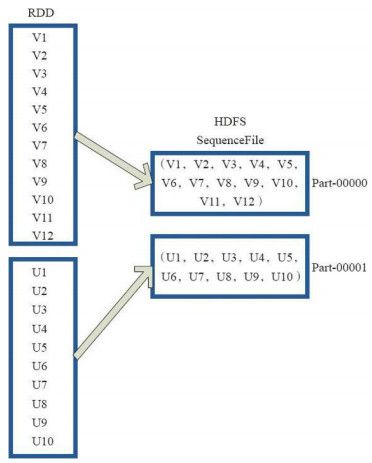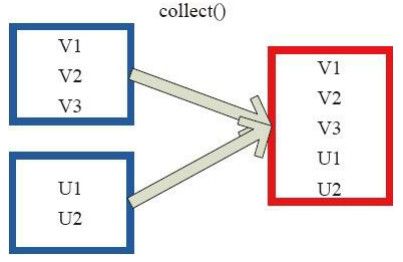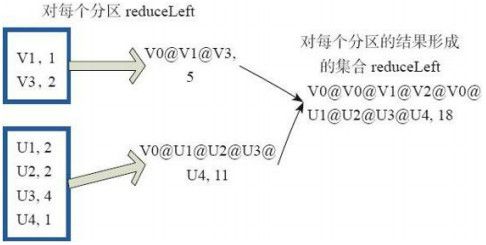【Spark】RDD操作详解4——Action算子
本质上在Actions算子中通过SparkContext执行提交作业的runJob操作,触发了RDD DAG的执行。
根据Action算子的输出空间将Action算子进行分类:无输出、 HDFS、 Scala集合和数据类型。
无输出
foreach
对RDD中的每个元素都应用f函数操作,不返回RDD和Array,而是返回Uint。

图中,foreach算子通过用户自定义函数对每个数据项进行操作。 本例中自定义函数为println,控制台打印所有数据项。
源码:
/** * Applies a function f to all elements of this RDD. */
def foreach(f: T => Unit) {
val cleanF = sc.clean(f)
sc.runJob(this, (iter: Iterator[T]) => iter.foreach(cleanF))
}HDFS
(1)saveAsTextFile
函数将数据输出,存储到HDFS的指定目录。将RDD中的每个元素映射转变为(Null,x.toString),然后再将其写入HDFS。

图中,左侧的方框代表RDD分区,右侧方框代表HDFS的Block。 通过函数将RDD的每个分区存储为HDFS中的一个Block。
源码:
/** * Save this RDD as a text file, using string representations of elements. */
def saveAsTextFile(path: String) {
// https://issues.apache.org/jira/browse/SPARK-2075
//
// NullWritable is a `Comparable` in Hadoop 1.+, so the compiler cannot find an implicit
// Ordering for it and will use the default `null`. However, it's a `Comparable[NullWritable]`
// in Hadoop 2.+, so the compiler will call the implicit `Ordering.ordered` method to create an
// Ordering for `NullWritable`. That's why the compiler will generate different anonymous
// classes for `saveAsTextFile` in Hadoop 1.+ and Hadoop 2.+.
//
// Therefore, here we provide an explicit Ordering `null` to make sure the compiler generate
// same bytecodes for `saveAsTextFile`.
val nullWritableClassTag = implicitly[ClassTag[NullWritable]]
val textClassTag = implicitly[ClassTag[Text]]
val r = this.mapPartitions { iter =>
val text = new Text()
iter.map { x =>
text.set(x.toString)
(NullWritable.get(), text)
}
}
RDD.rddToPairRDDFunctions(r)(nullWritableClassTag, textClassTag, null)
.saveAsHadoopFile[TextOutputFormat[NullWritable, Text]](path)
}
/** * Save this RDD as a compressed text file, using string representations of elements. */
def saveAsTextFile(path: String, codec: Class[_ <: CompressionCodec]) {
// https://issues.apache.org/jira/browse/SPARK-2075
val nullWritableClassTag = implicitly[ClassTag[NullWritable]]
val textClassTag = implicitly[ClassTag[Text]]
val r = this.mapPartitions { iter =>
val text = new Text()
iter.map { x =>
text.set(x.toString)
(NullWritable.get(), text)
}
}
RDD.rddToPairRDDFunctions(r)(nullWritableClassTag, textClassTag, null)
.saveAsHadoopFile[TextOutputFormat[NullWritable, Text]](path, codec)
}(2)saveAsObjectFile
saveAsObjectFile将分区中的每10个元素组成一个Array,然后将这个Array序列化,映射为(Null,BytesWritable(Y))的元素,写入HDFS为SequenceFile的格式。

图中,左侧方框代表RDD分区,右侧方框代表HDFS的Block。 通过函数将RDD的每个分区存储为HDFS上的一个Block。
源码:
/** * Save this RDD as a SequenceFile of serialized objects. */
def saveAsObjectFile(path: String) {
this.mapPartitions(iter => iter.grouped(10).map(_.toArray))
.map(x => (NullWritable.get(), new BytesWritable(Utils.serialize(x))))
.saveAsSequenceFile(path)
}Scala集合和数据类型
(1)collect
collect相当于toArray,toArray已经过时不推荐使用,collect将分布式的RDD返回为一个单机的scala Array数组。 在这个数组上运用scala的函数式操作。

图中,左侧方框代表RDD分区,右侧方框代表单机内存中的数组。通过函数操作,将结果返回到Driver程序所在的节点,以数组形式存储。
源码:
/** * Return an array that contains all of the elements in this RDD. */
def collect(): Array[T] = {
val results = sc.runJob(this, (iter: Iterator[T]) => iter.toArray)
Array.concat(results: _*)
}(2)collectAsMap
collectAsMap对(K,V)型的RDD数据返回一个单机HashMap。对于重复K的RDD元素,后面的元素覆盖前面的元素。

图中,左侧方框代表RDD分区,右侧方框代表单机数组。数据通过collectAsMap函数返回给Driver程序计算结果,结果以HashMap形式存储。
源码:
/** * Return the key-value pairs in this RDD to the master as a Map. * * Warning: this doesn't return a multimap (so if you have multiple values to the same key, only * one value per key is preserved in the map returned) */
def collectAsMap(): Map[K, V] = {
val data = self.collect()
val map = new mutable.HashMap[K, V]
map.sizeHint(data.length)
data.foreach { pair => map.put(pair._1, pair._2) }
map
}(3)reduceByKeyLocally
实现的是先reduce再collectAsMap的功能,先对RDD的整体进行reduce操作,然后再收集所有结果返回为一个HashMap。
源码:
/** * Merge the values for each key using an associative reduce function, but return the results * immediately to the master as a Map. This will also perform the merging locally on each mapper * before sending results to a reducer, similarly to a "combiner" in MapReduce. */
def reduceByKeyLocally(func: (V, V) => V): Map[K, V] = {
if (keyClass.isArray) {
throw new SparkException("reduceByKeyLocally() does not support array keys")
}
val reducePartition = (iter: Iterator[(K, V)]) => {
val map = new JHashMap[K, V]
iter.foreach { pair =>
val old = map.get(pair._1)
map.put(pair._1, if (old == null) pair._2 else func(old, pair._2))
}
Iterator(map)
} : Iterator[JHashMap[K, V]]
val mergeMaps = (m1: JHashMap[K, V], m2: JHashMap[K, V]) => {
m2.foreach { pair =>
val old = m1.get(pair._1)
m1.put(pair._1, if (old == null) pair._2 else func(old, pair._2))
}
m1
} : JHashMap[K, V]
self.mapPartitions(reducePartition).reduce(mergeMaps)
}(4)lookup
Lookup函数对(Key,Value)型的RDD操作,返回指定Key对应的元素形成的Seq。这个函数处理优化的部分在于,如果这个RDD包含分区器,则只会对应处理K所在的分区,然后返回由(K,V)形成的Seq。如果RDD不包含分区器,则需要对全RDD元素进行暴力扫描处理,搜索指定K对应的元素。

图中,左侧方框代表RDD分区,右侧方框代表Seq,最后结果返回到Driver所在节点的应用中。
源码:
/** * Return the list of values in the RDD for key `key`. This operation is done efficiently if the * RDD has a known partitioner by only searching the partition that the key maps to. */
def lookup(key: K): Seq[V] = {
self.partitioner match {
case Some(p) =>
val index = p.getPartition(key)
val process = (it: Iterator[(K, V)]) => {
val buf = new ArrayBuffer[V]
for (pair <- it if pair._1 == key) {
buf += pair._2
}
buf
} : Seq[V]
val res = self.context.runJob(self, process, Array(index), false)
res(0)
case None =>
self.filter(_._1 == key).map(_._2).collect()
}
}(5)count
count返回整个RDD的元素个数。

图中,返回数据的个数为5。一个方块代表一个RDD分区。
源码:
/** * Return the number of elements in the RDD. */
def count(): Long = sc.runJob(this, Utils.getIteratorSize _).sum(6)top
top可返回最大的k个元素。
相近函数说明:
- top返回最大的k个元素。
- take返回最小的k个元素。
- takeOrdered返回最小的k个元素, 并且在返回的数组中保持元素的顺序。
- first相当于top( 1) 返回整个RDD中的前k个元素, 可以定义排序的方式Ordering[T]。返回的是一个含前k个元素的数组。
源码:
/** * Returns the top k (largest) elements from this RDD as defined by the specified * implicit Ordering[T]. This does the opposite of [[takeOrdered]]. For example: * {{{ * sc.parallelize(Seq(10, 4, 2, 12, 3)).top(1) * // returns Array(12) * * sc.parallelize(Seq(2, 3, 4, 5, 6)).top(2) * // returns Array(6, 5) * }}} * * @param num k, the number of top elements to return * @param ord the implicit ordering for T * @return an array of top elements */
def top(num: Int)(implicit ord: Ordering[T]): Array[T] = takeOrdered(num)(ord.reverse)(7)reduce
reduce函数相当于对RDD中的元素进行reduceLeft函数的操作。
reduceLeft先对两个元素
/** * Reduces the elements of this RDD using the specified commutative and * associative binary operator. */
def reduce(f: (T, T) => T): T = {
val cleanF = sc.clean(f)
val reducePartition: Iterator[T] => Option[T] = iter => {
if (iter.hasNext) {
Some(iter.reduceLeft(cleanF))
} else {
None
}
}
var jobResult: Option[T] = None
val mergeResult = (index: Int, taskResult: Option[T]) => {
if (taskResult.isDefined) {
jobResult = jobResult match {
case Some(value) => Some(f(value, taskResult.get))
case None => taskResult
}
}
}
sc.runJob(this, reducePartition, mergeResult)
// Get the final result out of our Option, or throw an exception if the RDD was empty
jobResult.getOrElse(throw new UnsupportedOperationException("empty collection"))
}(8)fold
fold和reduce的原理相同,但是与reduce不同,相当于每个reduce时,迭代器取的第一个元素是zeroValue。

图中,通过用户自定义函数进行fold运算,图中的一个方框代表一个RDD分区。
源码:
/** * Aggregate the elements of each partition, and then the results for all the partitions, using a * given associative function and a neutral "zero value". The function op(t1, t2) is allowed to * modify t1 and return it as its result value to avoid object allocation; however, it should not * modify t2. */
def fold(zeroValue: T)(op: (T, T) => T): T = {
// Clone the zero value since we will also be serializing it as part of tasks
var jobResult = Utils.clone(zeroValue, sc.env.closureSerializer.newInstance())
val cleanOp = sc.clean(op)
val foldPartition = (iter: Iterator[T]) => iter.fold(zeroValue)(cleanOp)
val mergeResult = (index: Int, taskResult: T) => jobResult = op(jobResult, taskResult)
sc.runJob(this, foldPartition, mergeResult)
jobResult
}(9)aggregate
aggregate先对每个分区的所有元素进行aggregate操作,再对分区的结果进行fold操作。
aggreagate与fold和reduce的不同之处在于,aggregate相当于采用归并的方式进行数据聚集,这种聚集是并行化的。 而在fold和reduce函数的运算过程中,每个分区中需要进行串行处理,每个分区串行计算完结果,结果再按之前的方式进行聚集,并返回最终聚集结果。

图中,通过用户自定义函数对RDD 进行aggregate的聚集操作,图中的每个方框代表一个RDD分区。
源码:
/** * Aggregate the elements of each partition, and then the results for all the partitions, using * given combine functions and a neutral "zero value". This function can return a different result * type, U, than the type of this RDD, T. Thus, we need one operation for merging a T into an U * and one operation for merging two U's, as in scala.TraversableOnce. Both of these functions are * allowed to modify and return their first argument instead of creating a new U to avoid memory * allocation. */
def aggregate[U: ClassTag](zeroValue: U)(seqOp: (U, T) => U, combOp: (U, U) => U): U = {
// Clone the zero value since we will also be serializing it as part of tasks
var jobResult = Utils.clone(zeroValue, sc.env.closureSerializer.newInstance())
val cleanSeqOp = sc.clean(seqOp)
val cleanCombOp = sc.clean(combOp)
val aggregatePartition = (it: Iterator[T]) => it.aggregate(zeroValue)(cleanSeqOp, cleanCombOp)
val mergeResult = (index: Int, taskResult: U) => jobResult = combOp(jobResult, taskResult)
sc.runJob(this, aggregatePartition, mergeResult)
jobResult
}转载请注明作者Jason Ding及其出处
GitCafe博客主页(http://jasonding1354.gitcafe.io/)
Github博客主页(http://jasonding1354.github.io/)
CSDN博客(http://blog.csdn.net/jasonding1354)
简书主页(http://www.jianshu.com/users/2bd9b48f6ea8/latest_articles)
Google搜索jasonding1354进入我的博客主页